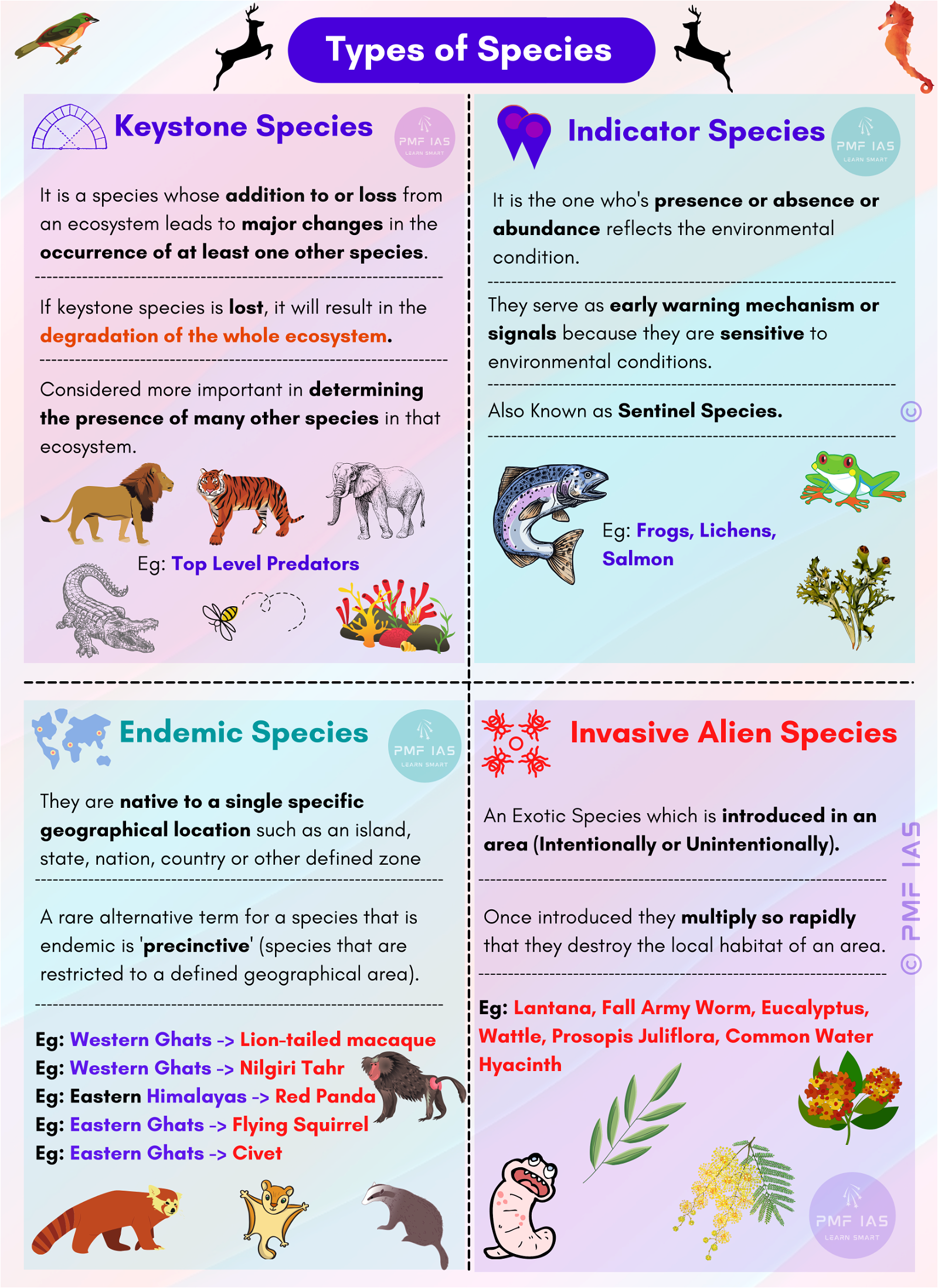
Daily Prelims Practise Questions (PPQs) – October 21, 2023
Subscribe to Never Miss an Important Update! Assured Discounts on New Products!
Must Join PMF IAS Telegram Channel & PMF IAS History Telegram Channel
Questions
- The questions below are based on PMF IAS Daily Current Affairs – October 2023.
Q1. {Polity – IC – Constitutional Bodies} Consider the following statements regarding the National Commission for Backward Class (NCBC):
- The National Commission for Backward Class (NCBC) was set up in 1993 by an act of Parliament.
- The 100th Constitutional Amendment Act of 2018 gave constitutional status to the National Commission for Backward Class (NCBC).
- The National Commission for Backward Class (NCBC) is responsible for investigating and monitoring the implementation of safeguards for the Backward classes, including Scheduled Castes as provided under the Constitution and other laws.
Which of the above statement(s) is/are correct?
- 1 only
- 2 only
- 2 and 3 only
- 1 and 3 only
Q2. {Polity – IC – Parliament} Consider the following statements about Question Hour in Parliament:
- A starred question is the one that receives a written reply from the Ministry.
- An unstarred question is asked by a Member of Parliament and answered orally by the Minister-in-charge.
- Unlike starred questions, unstarred questions don’t permit any follow-up questions.
- Short notice questions are ones pertaining to a matter of urgent public importance and can only be introduced in Lok Sabha.
How many of the statement(s) above is/are correct?
- Only one
- Only two
- Only three
- All of the above
Q3. {Vulnerable Sections – Women} Consider the following statements regarding the Prevention of Sexual Harassment (PoSH) Act:
- The act provides for forming an Internal Complaints Committee (ICC) for all institutions with a female employee.
- The Internal Complaints Committee has to be headed by the Chairman/Managing Director of the institution.
- The safeguards under the Prevention of Sexual Harassment (PoSH) Act do not apply to ‘male victims’.
How many of the above statement(s) is/are correct?
- Only one
- Only two
- Only three
- None of the above
Q4. {Agri – Crops} With reference to ‘Palm oil’, consider the following statements: (PYQ)
- The palm oil tree is native to Southeast Asia.
- Palm oil is a raw material for some industries producing lipstick and perfumes.
- Palm oil can be used to produce biodiesel.
Which of the above statement(s) is/are correct?
- 1 and 2
- 2 and 3
- 1 and 3
- 1, 2 and 3
Q5. {Agri – Schemes} Consider the following statements regarding ‘Ghar-Ghar KCC Abhiyaan’:
- ‘Ghar-Ghar KCC Abhiyaan’ is a campaign that extends the Kisan Credit Card (KCC) Scheme to all Indian farmers.
- The Ministry of Agriculture is the primary executing authority for Ghar-Ghar KCC Abhiyaan.
- The credit limit of a Kisan Credit Card is the same for all beneficiaries.
Which of the above statement(s) is/are incorrect?
- 1 and 2 only
- 2 and 3 only
- 1 and 3 only
- 1, 2 and 3
Q6. {Envi – Species} What is the species ‘Haploclastus nilgirinus’ which was in the news recently?
- It is an endangered mountain ungulate endemic to the Nilgiri Hills of the Western Ghats.
- It is a venomous tarantula endemic to the Nilgiri Hills of the Western Ghats.
- It is the only marten species native to southern India that lives in the hills of the Nilgiris and parts of the Western Ghats.
- It is an Old World flycatcher with a very restricted range in the hills of southern India.
Note: UPSC has never asked questions based on scientific names except in cases where the species is extremely important.
Q7. {Envi – Species} Consider the following statements regarding ‘Galápagos Giant Tortoises’:
- This iconic species from the Galápagos is only found on the Galápagos Islands.
- They are herbivorous, long-lived animals with lifespans in the wild of over 150 years.
- They are considered keystone species even though their role as the architects of the ecosystem is insignificant because of their sedate nature.
Which of the above statement(s) is/are correct?
- 1 and 2 only
- 2 and 3 only
- 1 only
- 3 only
Questions With Solution and Explanation
Q1. {Polity – IC – Constitutional Bodies} Consider the following statements regarding the National Commission for Backward Class (NCBC):
- The National Commission for Backward Class (NCBC) was set up in 1993 by an act of Parliament.
- The 100th Constitutional Amendment Act of 2018 gave constitutional status to the National Commission for Backward Class (NCBC).
- The National Commission for Backward Class (NCBC) is responsible for investigating and monitoring the implementation of safeguards for the Backward classes, including Scheduled Castes as provided under the Constitution and other laws.
Which of the above statement(s) is/are correct?
- 1 only
- 2 only
- 2 and 3 only
- 1 and 3 only
Explanation
Statement 1 is correct
- The National Commission for Backward Classes was set up in 1993 by an act of Parliament.
Statement 2 is incorrect.
- The 102nd Constitutional Amendment Act 2018 gave constitutional status to the National Commission for Backward Classes.
- The 100th Constitutional Amendment Act 2015 ratified the land boundary agreement between India and Bangladesh.
Statement 3 is incorrect
- The National Commission for Backward Class is responsible for investigating and monitoring the implementation of safeguards for the backward classes as provided under the Constitution & other laws.
- The National Commission for Scheduled Caste is responsible for investigating, monitoring and implementing safeguards for Scheduled Castes.
Answer: (a) 1 only
Q2. {Polity – IC – Parliament} Consider the following statements about Question Hour in Parliament:
- A starred question is the one that receives a written reply from the Ministry.
- An unstarred question is asked by a Member of Parliament and answered orally by the Minister-in-charge.
- Unlike starred questions, unstarred questions don’t permit any follow-up questions.
- Short notice questions are ones pertaining to a matter of urgent public importance and can only be introduced in Lok Sabha.
How many of the statement(s) above is/are correct?
- Only one
- Only two
- Only three
- All of the above
Explanation
Statement 1 is incorrect
- A starred question is asked by an MP and answered orally by the Minister-in-charge.
- Each Member of Parliament is allowed to ask one starred question per day.
Statement 2 is incorrect
- An unstarred question receives a written reply from the Ministry.
- These also need to be submitted at least 15 days in advance.
Statement 3 is correct
- Unlike starred questions, unstarred questions don’t permit any follow-up questions.
Statement 4 is incorrect
- Short notice questions are ones pertaining to a matter of urgent public importance. It can be introduced in Both houses.
Answer: (a) Only one
Q3. {Vulnerable Sections – Women} Consider the following statements regarding the Prevention of Sexual Harassment (PoSH) Act:
- The act provides for forming an Internal Complaints Committee (ICC) for all institutions with a female employee.
- The Internal Complaints Committee has to be headed by the Chairman/Managing Director of the institution.
- The safeguards under the Prevention of Sexual Harassment (PoSH) Act do not apply to ‘male victims’.
How many of the above statement(s) is/are correct?
- Only one
- Only two
- Only three
- None of the above
Explanation
Statement 1 is incorrect
- The PoSH Act or Sexual Harassment of Women at Workplace (Prevention, Prohibition & Redressal) Act was enacted in 2013 to implement the Vishakha guideline.
- The law requires any employer with over ten employees to form an Internal Complaints Committee.
Statement 2 is incorrect
- The Internal Complaints Committee must be headed by a woman and have at least two female employees, another employee (gender not specified), and a third party, such as an NGO worker with five years of experience.
Statement 3 is correct
- The Prevention of Sexual Harassment (PoSH) Act is not Gender Neutral. The safeguards under the Prevention of Sexual Harassment (PoSH) Act do not apply to ‘male victims’.
Answer: (a) Only one
Q4. {Agri – Crops} With reference to ‘Palm oil’, consider the following statements: (PYQ)
- The palm oil tree is native to Southeast Asia.
- Palm oil is a raw material for some industries producing lipstick and perfumes.
- Palm oil can be used to produce biodiesel.
Which of the above statement(s) is/are correct?
- 1 and 2
- 2 and 3
- 1 and 3
- 1, 2 and 3
Explanation
Statement 1 is incorrect
- Palm oil is derived from the oil palm tree, which is native to West Africa and grows best in tropical climates with abundant water.
Statement 2 is correct
- Conventionally, Volatile short-chain fatty Acid (VSCFA), derived from Palm oil, has been widely used as raw material in the fragrant industry to produce perfume via the esterification process.
Statement 3 is correct
- If refined, the Palm Oil can be applied directly as boiler fuel, raw material for biodiesel production.
Answer: (b) 2 and 3 only
Q5. {Agri – Schemes} Consider the following statements regarding ‘Ghar-Ghar KCC Abhiyaan’:
- ‘Ghar-Ghar KCC Abhiyaan’ is a campaign that extends the Kisan Credit Card (KCC) Scheme to all Indian farmers.
- The Ministry of Agriculture is the primary executing authority for Ghar-Ghar KCC Abhiyaan.
- The credit limit of a Kisan Credit Card is the same for all beneficiaries.
Which of the above statement(s) is/are incorrect?
- 1 and 2 only
- 2 and 3 only
- 1 and 3 only
- 1, 2 and 3
Explanation
Statement 1 is correct
- ‘Ghar-Ghar KCC Abhiyaan’ is a campaign that extends the Kisan Credit Card (KCC) Scheme to all Indian farmers.
Statement 2 is incorrect
- NABARD is the primary executing organisation for Ghar-Ghar KCC Abhiyaan.
Statement 3 is incorrect
- The credit limit is fixed based on operational land holding, cropping pattern, and scale of finance, of beneficiaries.
Answer: (d) 2 and 3 only
Q6. {Envi – Species} What is the species ‘Haploclastus nilgirinus’ which was in the news recently?
- It is an endangered mountain ungulate endemic to the Nilgiri Hills of the Western Ghats.
- It is a venomous tarantula endemic to the Nilgiri Hills of the Western Ghats.
- It is the only marten species native to southern India that lives in the hills of the Nilgiris and parts of the Western Ghats.
- It is an Old World flycatcher with a very restricted range in the hills of southern India.
Explanation
Statement (b) is correct; statement (a), (c), and (d) are incorrect
- Nilgiri Large Burrowing Spider (Haploclastus nilgirinus) is a venomous tarantula endemic to the Nilgiri Hills of the Western Ghats.
- Nilgiri large burrowing spider is threatened by illegal trade, habitat loss, etc.
- It is also a nocturnal species, which lives in burrows that it digs in the ground.
Answer: (b) it is a venomous tarantula endemic to the Nilgiri Hills of the Western Ghats
Note: UPSC has never asked questions based on scientific names except in cases where the species is extremely important.
Q7. {Envi – Species} Consider the following statements regarding ‘Galápagos Giant Tortoises’:
- This iconic species from the Galápagos is only found on the Galápagos Islands.
- They are herbivorous, long-lived animals with lifespans in the wild of over 150 years.
- They are considered keystone species even though their role as the architects of the ecosystem is insignificant because of their sedate nature.
Which of the above statement(s) is/are correct?
- 1 and 2 only
- 2 and 3 only
- 1 only
- 3 only
Explanation
Statement (1) is correct
- The Galápagos giant tortoise is endemic to the Galápagos Islands (Ecuador), a volcanic archipelago in the Eastern Pacific.
- It is an iconic species from the Galápagos and is only found on these islands.
Statement (2) is incorrect
- They are herbivorous, long-lived animals with lifespans in the wild of over 100 years.
|
Difference between Turtle and Tortoise |
|
|
Turtles |
Tortoises |
| Turtles are water-dwelling reptiles. | Tortoises are land-dwelling reptiles. |
| They come to land to lay eggs. | They do everything on land. |
| They are good swimmers (fore and hind limbs are modified into paddles). | They are bad swimmers (fore and hind limbs are not modified into paddles). |
| Majority of them are carnivores, while some are
omnivores and very few are herbivores. |
They are herbivores. |
| They are comparatively smaller in size. | They are generally large in size. |
| They usually have short life span (20-40 years). | They usually have long life span (80-120 years). |
| Their heads can partially withdraw into shells. | Their heads can completely withdraw into shells. |
| Not all turtles are tortoises. | All tortoises are turtles as they belong to the order Testudines or Chelonia (reptiles having bodies encased in a bony shell). |
|
|
|
Statement (3) is incorrect
Galapagos Giant Tortoises: As Ecological Architect:
- Seed dispersal
- Grazing: This prevents the growth of woody plants, which shade small plants and create open areas important for other animals, such as birds and lizards.
- Trampling: Trampling can break up hard soils and create openings in the canopy, creating opportunities for new plants to grow.
- Dung: Their dung is a valuable source of nutrients for plants.






![PMF IAS Environment for UPSC 2022-23 [paperback] PMF IAS [Nov 30, 2021]…](https://pmfias.b-cdn.net/wp-content/uploads/2024/04/pmfiasenvironmentforupsc2022-23paperbackpmfiasnov302021.jpg)













